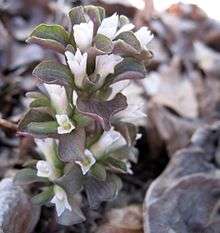Obolaria
Obolaria virginica, commonly known as Virginia pennywort,[1] is a species of flowering plant in the gentian family. It is monotypic, with no other species in the genus Obolaria.
| Obolaria | |
|---|---|
 | |
| Scientific classification | |
| Kingdom: | Plantae |
| Clade: | Tracheophytes |
| Clade: | Angiosperms |
| Clade: | Eudicots |
| Clade: | Asterids |
| Order: | Gentianales |
| Family: | Gentianaceae |
| Tribe: | Gentianeae |
| Subtribe: | Swertiinae |
| Genus: | Obolaria L. |
| Species: | O. virginica |
| Binomial name | |
| Obolaria virginica L. | |
It is native to the eastern United States,[2] where it is found in nutrient-rich forests. It is believed to be mycoheterotrophic, getting much of its nutrients though a symbiotic relationship with fungi, instead of through its small purplish-green leaves.[3][4]
It is a perennial that produces white flowers in the spring. It is often difficult to locate due to its small stature, and tendency to be buried under leaf litter.[3][5]
References
- "Obolaria virginica". Natural Resources Conservation Service PLANTS Database. USDA. Retrieved 13 January 2017.
- "Obolaria virginica". County-level distribution map from the North American Plant Atlas (NAPA). Biota of North America Program (BONAP). 2014. Retrieved 13 January 2017.
- "Flora of the Southern and Mid-Atlantic States".
- Cameron, Duncan; Bolin, Jay (2010). "Isotopic evidence of partial mycoheterotrophy in the Gentianaceae: Bartonia virginica and Obolaria virginica as case studies". American Journal of Botany. 97 (8): 1272–1277. doi:10.3732/ajb.0900292. PMID 21616879.
- Missouri Plants
This article is issued from Wikipedia. The text is licensed under Creative Commons - Attribution - Sharealike. Additional terms may apply for the media files.